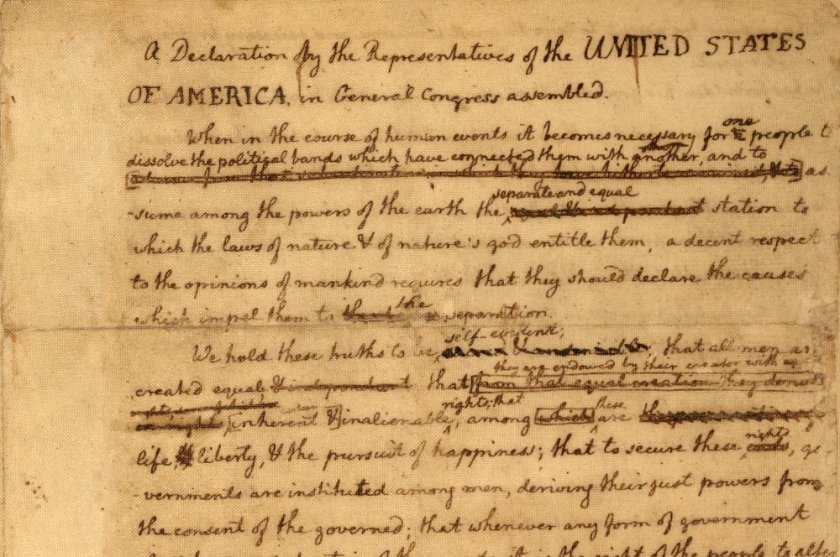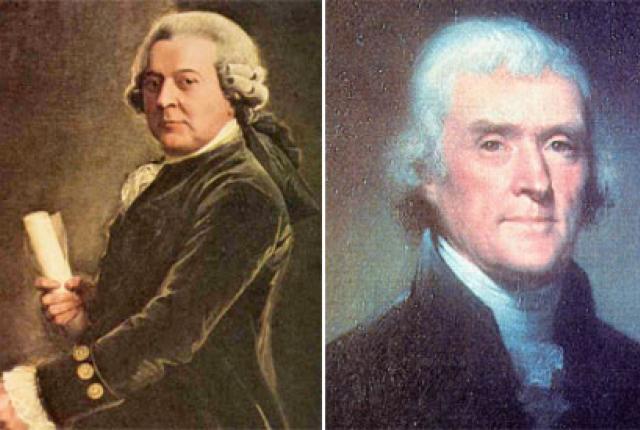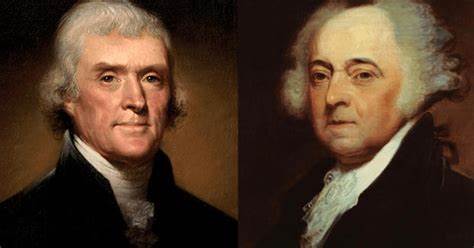On June 7, 1776, Richard Henry Lee delivered the all-important resolution of the founding era, before the assembled delegates of the 2nd Continental Congress: “Resolved, that these United Colonies are, and of right ought to be, free and independent States...”

Congress appointed three overlapping committees to draft a formal declaration of independence, a model treaty for the conduct of international relations and a document by which this confederation of states, was to be governed. Already appointed to the Committee of Confederation, Lee was urged to join the Declaration committee, as well. Believing that two such committees were too much and burdened with the care of a critically ill wife, he demurred.
So it is a committee of five was appointed to write the Declaration of Independence, including Benjamin Franklin of Pennsylvania, Roger Sherman of Connecticut, Robert R. Livingston of New York, Massachusetts attorney John Adams and a young Virginia delegate named Thomas Jefferson.
Jefferson had no interest in writing the Declaration of Independence and suggested Adams pen the first draft. Adams declined, and described the following conversation, in a letter to Massachusetts politician Timothy Pickering:
“Jefferson proposed to me to make the draft. I said, ‘I will not,’ ‘You should do it.’ ‘Oh! no.’ ‘Why will you not? You ought to do it.’ ‘I will not.’ ‘Why?’ ‘Reasons enough.’ ‘What can be your reasons?’ ‘Reason first, you are a Virginian, and a Virginian ought to appear at the head of this business. Reason second, I am obnoxious, suspected, and unpopular. You are very much otherwise. Reason third, you can write ten times better than I can.’ ‘Well,’ said Jefferson, ‘if you are decided, I will do as well as I can.’ ‘Very well. When you have drawn it up, we will have a meeting.”
Fellow committee members agreed. Thomas Jefferson spent the following seventeen days, writing the first draft. He and Adams had only just met during the Continental Congress in Philadelphia. The two would develop a close personal friendship which would last for the rest of their lives.

To be more precise, the friendship between the two men would last, for much of their lives. That came to an ugly end during the Presidential election of 1800, in which mudslinging and personal attacks from both sides rose to levels never before witnessed in a national election.
Jefferson defeated one-term incumbent Adams and went on to serve two terms as President of the United States. Upon Jefferson’s retirement in 1809, Dr. Benjamin Rush, one of the Declaration’s signers, took it upon himself to patch up the broken friendship between the two founding fathers.
For two years Dr. Rush worked on this personal diplomatic mission. In 1811, he succeeded.

There followed a series of letters between John Adams and Thomas Jefferson, which together constitute one of the most comprehensive historical and philosophical assessments ever written about the American founding.
The correspondence between the pair touched on a variety of topics, from the birth of a self-governing Constitutional Republic, to then-current political issues to matters of philosophy and religion and personal issues related to the advancement, of years.
Both men understood. They were writing not only to one another, but to generations yet unborn. Each went to great lengths to explain the philosophical underpinnings of his views. Adams the firm believer in strong, centralized government, Jefferson advocating a small federal government, deferential to the states.
By 1826, Jefferson and Adams were among the last survivors among the founding generation. Only a handful yet remained.
No fiction author, no Hollywood screenwriter would dare put to paper an ending so unlikely, so unbelievable, as that which then took place. These two men, central among the hundreds who gave us this self governing Republic, died on the same day. July 4, 1826. Fifty years to the day from the birth of the Republic, they had helped to create.
Adams was 90 as he lay on his deathbed, suffering from congestive heart failure. His last words were “Thomas Jefferson still survives”. He had no way to know. The author of the Declaration of Independence had died that morning, at his Monticello home. Jefferson was 82.

John Adams’ son John Quincy was himself President at the time of the two men’s passing, and remarked that the coincidence was among the “visible and palpable remarks of Divine Favor”.
A month after the two men passed, Daniel Webster spoke of these two men at Faneuil Hall, in Boston.
“No two men now live, (or) any two men have ever lived, in one age, who (have) given a more lasting direction to the current of human thought. No age will come, in which the American Revolution will appear less than it is, one of the greatest events in human history. No age will come, in which it will cease to be seen and felt, on either continent, that a mighty step, a great advance, not only in American affairs, but in human affairs, was made on the 4th of July 1776″.
A Blessed Independence Day, to you and yours. – Rick Long, the “ Cape Cod Curmudgeon”



You must be logged in to post a comment.